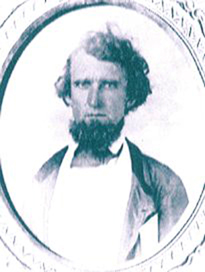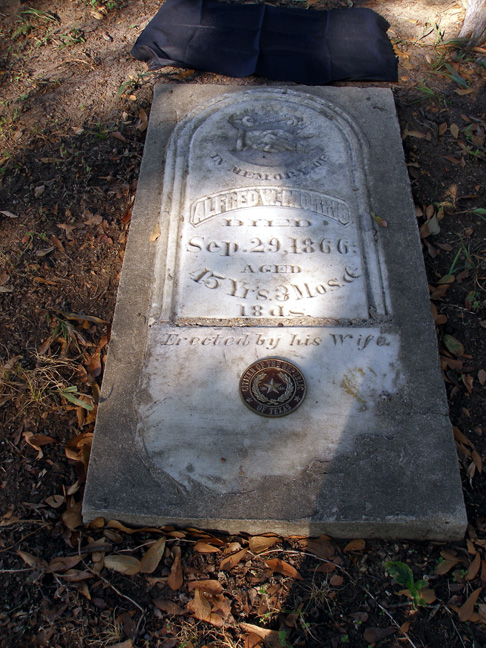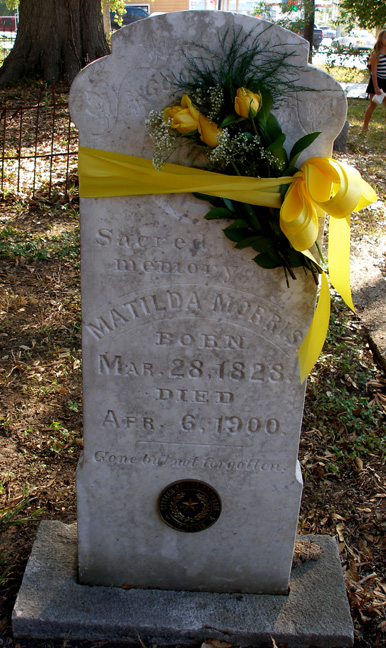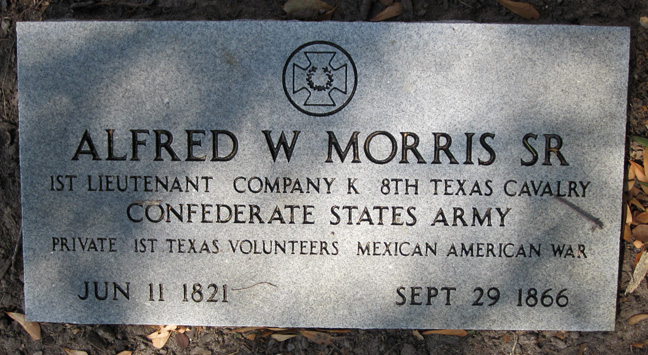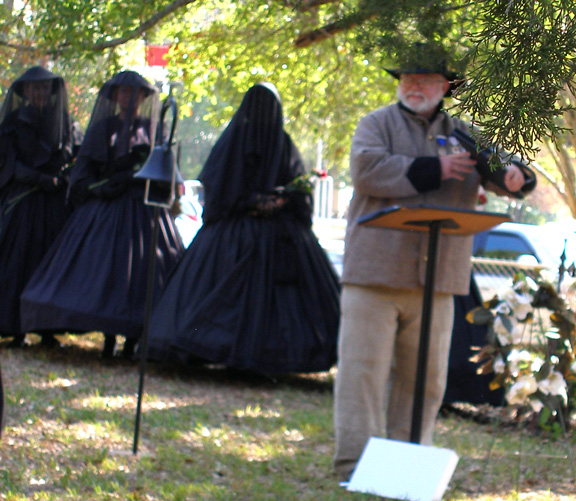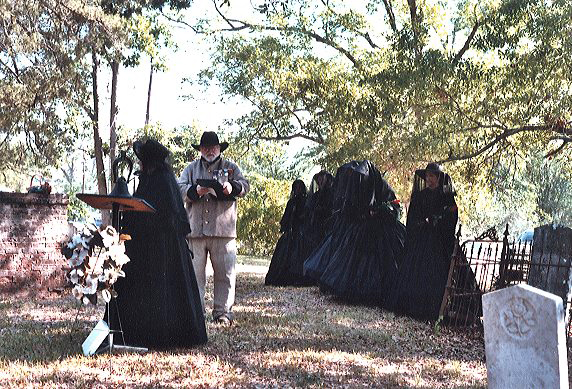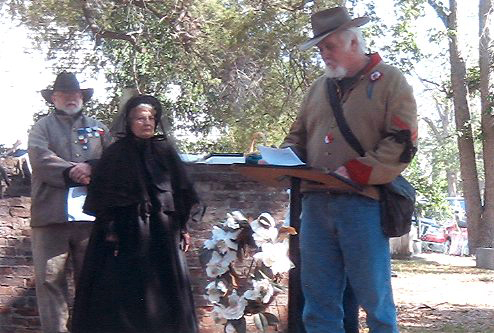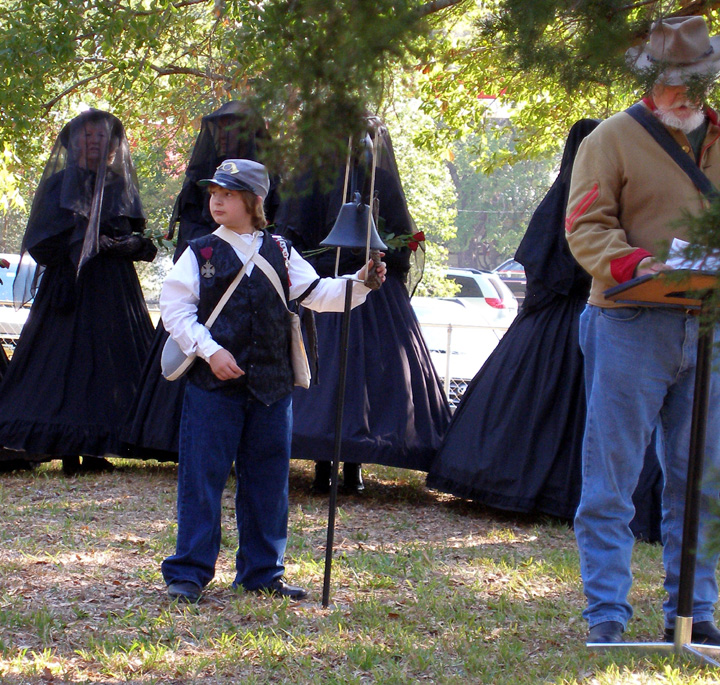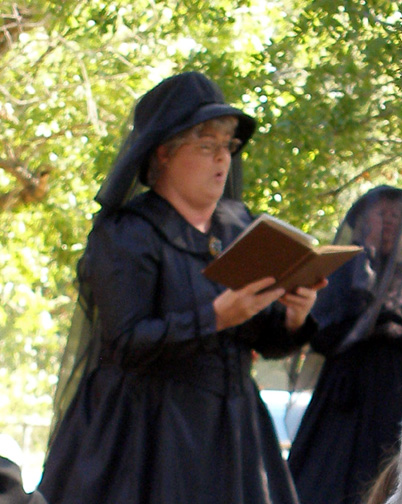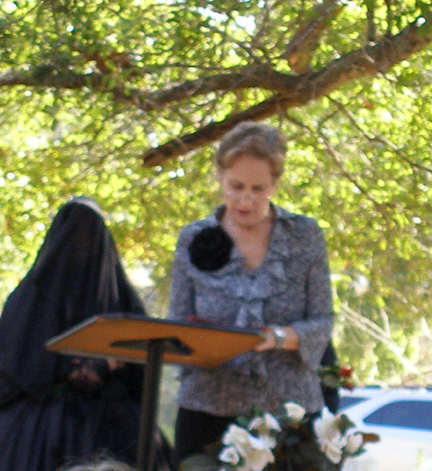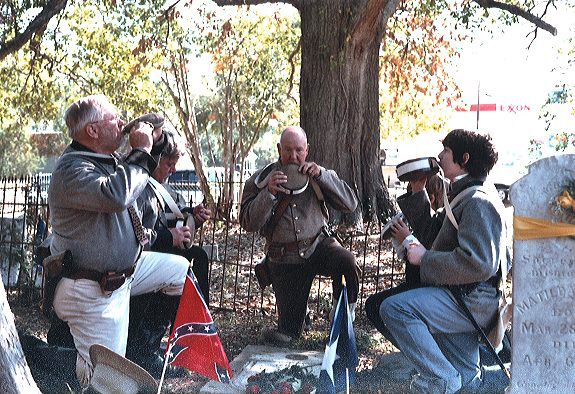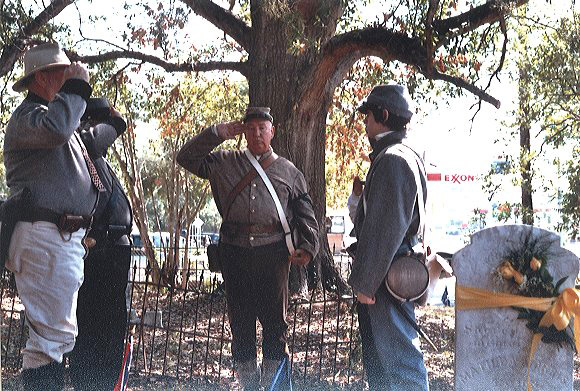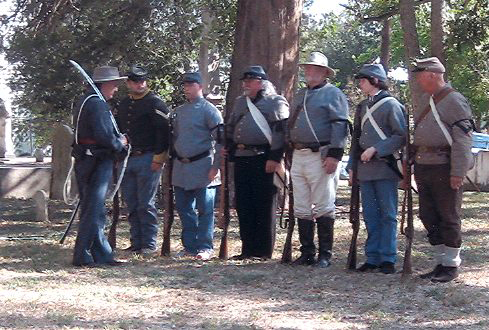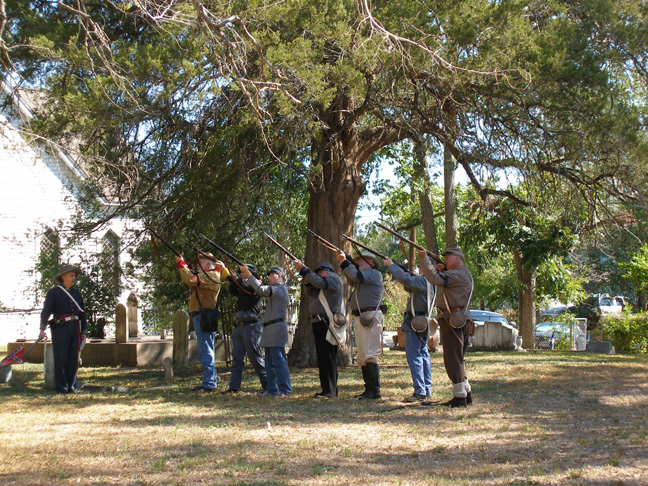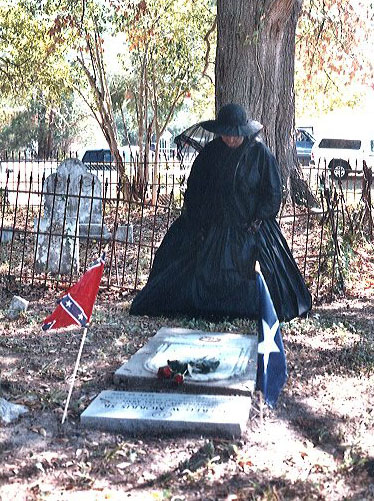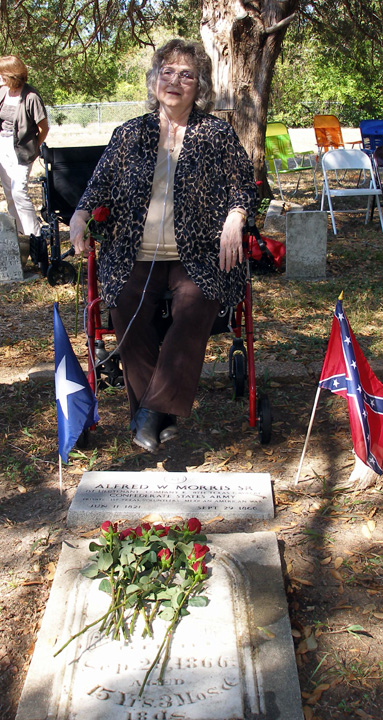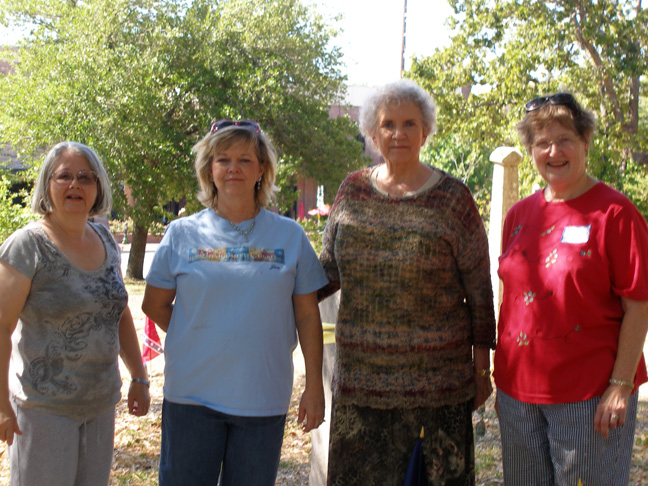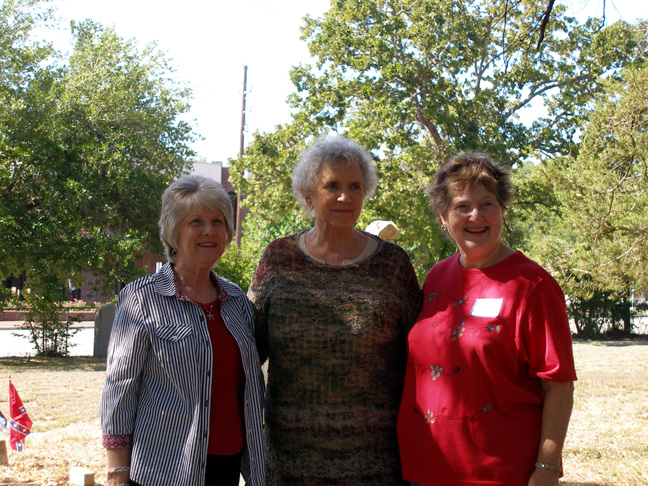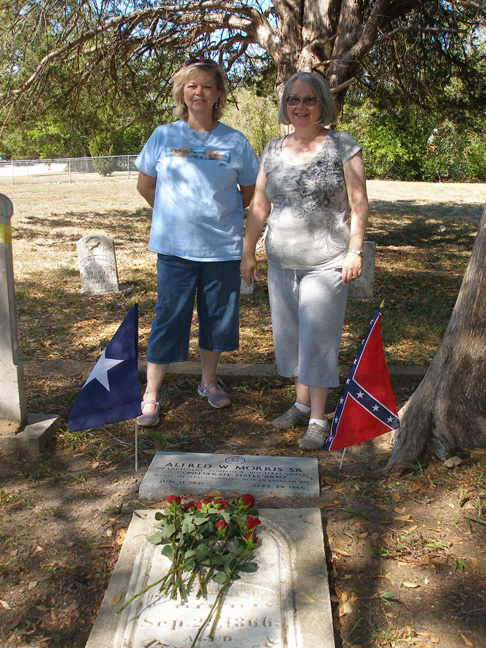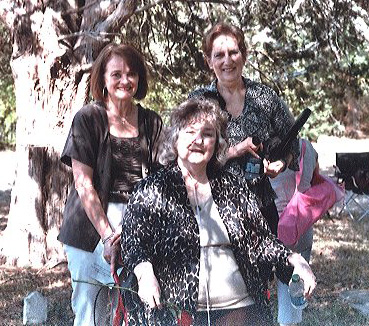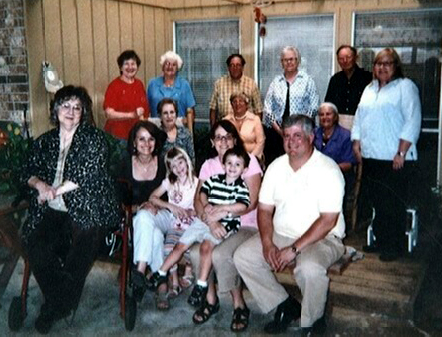
|
|
|
Jane and I can't thank Sarah Morris Cannon, a descendant of A.W. Morris, enough for extending an invitation for us to attend his Confederate Grave Marker Dedication and share with us the history of their ancestor A.W. Morris. |
|
|
The History of 1st Lt. Alfred W. Morris Good morning ladies and gentlemen! I would like to welcome you to this dedication ceremony honoring Alfred William Morris for his service to the confederate army. First, I want to tell you a little bit about him. He was known to family and friends as A.W.
Six years after Santa Anna's defeat at San Jacinto, Mexico still refused to recognize the independence of Texas,
and at least two military expeditions were made to recapture the country. In February, 1842, General Rafael Vasquez led a Mexican Army of some 400 men across the Rio Grande. By the first week in
March, the General had taken San Antonio. Fear spread throughout Texas that their independence was in jeopardy. That same March, A.W. joined a company of
Rangers from Harris County, Texas, which went as far west as the Rio Colorado. On Apr 1, 1844, A.W. applied for a third class headright land certificate in Jefferson TX. He was issued 320 acres
in Houston County on the Trinity River about 22 miles south of the town of Crockett. He would never live on this land and eventually sold it
in 1853. The next year, on February 22, 1845, A.W. would marry Matilda Parmer in Jasper County, Texas at the home of her brother-in-law and sister, Henry M. and Mary Ann Black. Matilda was the daughter of legendary Texas frontiersman Martin Parmer and Parmer’s wife a widow named Margaret Griffith Neal. A.W. and Matilda’s marriage would be a happy union resulting in the birth of seven children - three girls and four boys.
Their first child, a son named A.W. Jr. would be born the following year on January 10, 1846. Texas had just been annexed by the United States and war with Mexico soon broke out. The commanding general for the United States army was Zachary Taylor. Taylor had forces from many states but after a few engagements with the Mexicans he felt the need of men familiar with the terrain and opposition. He asked the governor of Texas for four Ranger regiments – two mounted and two foot. He received three – two mounted and one foot.
The Morris family moved from Newton County, Texas to Walker County, Texas sometime between 1846 and
1847. In 1847 A.W. was a member of Forest Masonic Lodge #19 in Huntsville, Texas but demitted by 1849. January of 1848 would see the discovery of Gold in California. That same year A.W. and Matilda would welcome
the birth of their first daughter Maggie in June. A. W. would become a “Forty-niner.” In April of 1849, he traveled overland with a group of men
from Walker County to the California Gold Rush. While A.W. was off exploring for gold his family would live with Matilda’s half-brother Anthony Palmer in Walker County. It is known from newspaper
accounts in May of 1850 that after six months of mining A.W. had earned about $500 in gold dust. In December of 1850, A.W. is enumerated,
with his brother-in-law Dr. John C. Black, as still mining for gold in Mariposa, California. The following year he joined an expeditionary party that went to South America. He returned to the states
aboard the SS Ohio in April of 1851. The Ohio was a postal ship that ran from New York to San Francisco. The last leg of his journey would include
a stop in Havana, Cuba before arriving in New Orleans. Mattie their second daughter would be born nine months later in January of 1852. In the mid 1850’s A.W. and several of his Palmer relatives bid on postal routes in East Texas. A. W. was
contracted to deliver the mail from Washington to Cold Spring once a week. His annual salary was $975. He was awarded the bid in April of 1854 and
commenced delivery in July. He would leave Washington every Monday at 6 a.m. expected to arrive in Cold Spring by noon on Tuesday. He then left Cold Spring by 1 p.m. on Tuesday and arrived back in
Washington by 7 p.m. on Wednesday. The term of the contract was for four years ending in 1858. Two more children would be born during this time period, son Martin in 1854 and son Ed in 1857. He was elected sheriff of Montgomery County on August 4, 1856, and began to serve in the fall of 1856 while he
was still making weekly mail deliveries. He was re-elected on August 2, 1858 and served until August 6, 1860. A.W. would join the army of the Confederacy on September 7, 1861. His fifteen year old son A.W. Jr. enlisted
with him. They became members of Company K of the 8th Cavalry. The 8th Cavalry was organized by B.F. Terry and T.S. Lubbock. Lubbock and Terry had conceived
the idea of organizing a cavalry regiment handpicked from the best men Texas had to offer. Many had been former Rangers and frontiersmen. It was a mounted unit and would become known
as Terry’s Texas Rangers after its commanding officer. Each man was required to furnish a shotgun or carbine, a Colt revolver, a Bowie knife, a
saddle, bridle, and blanket. The Confederate army would then provide the mounts. Originally bound for Virginia, the regiment was placed under the command of Albert Sydney Johnston and
traveled to Bowling Green, Kentucky, where they elected their officers and officially organized the regiment. A.W. would be elected first Lieutenant
and John G. Walker would be elected Captain of Company K by their peers. The regiment consisted of 1007 men but by November only 78 would answer roll call. Many had contracted
swamp fever as they passed through Louisiana. Others suffered from the harsh effects of the cold Kentucky winter and measles. From that day on, as the men recovered from disease, they returned for duty. On
the 7th day of December, intelligence predicted that there would be a fight before the holidays. To hear these sick men or boys, begging to be
restored quickly, so they would not miss the fight, was sad indeed. Soon rumor came that a fight was more and more eminent. To see them steal away
to the front created a scene that made us proud to be Texans. From this nucleus of less than one hundred men combined with the return of many who were sick, one hundred and eighty-one men went forth
that morning to do their first battle for their God and country. This premier engagement would be a horrific one occurring on December 17, 1861 in Woodsonville, Kentucky.
Colonel Terry divided his forces in two. Terry commanded the group to the left assisted by Senior Captain John G. Walker of Company K — while
Captain Ferrell commanded the group on the right side. Terry’s group consisted of 75 men. Newspaper accounts stated that they fought like 500. A Union account describing Terry’s Rangers said, “they
ride like Arabs and fight like devils”. Colonel Terry, expecting infantry and artillery support, had been misled. In so believing he charged an enemy many times his number. Terry led the charge followed by Captain Walker and Company K who was the advance company. The battle lasted until dark. Company K received the heaviest losses on the left while Captain Ferrell’s Company D sustained the heaviest on the right. In the daring charge Colonel Terry met his death; Capt. Walker was wounded by a bayonet passing through his right wrist; and A. W. was dangerously shot through his right arm breaking it and with a ball entering his lungs. The December 19th issue of the Nashville Union & American reported the death of Col. Terry and said “Lieutenant Morris of Captain Walker’s company was mortally wounded”.
Robert Bunting, a fellow Terry’s Ranger, would write on January 4th, 1862, “Lieutenant Morris, shot through the arm and lungs, but today encouragingly
comfortable, and ate slightly”. A.W. was hospitalized in Nashville at least through the end of January 1862. A.W. Jr. would help transport his father back to Texas in February. That spring, A.W.
would act as an enlistment agent in Montgomery County, TX. Meanwhile, back in Texas Matilda had given birth to their fourth son in January
1862. This child was named John Walker Morris no doubt to honor Captain John G. Walker. A.W. was forced to resign due to his battle wounds in August of 1862. That same month Texas Governor Francis
Lubbock recommended A.W. for Montgomery County provost Marshall. In October of 1864, their last child, a daughter called Rena was born. Rena was christened Cornelia Alexina
MacKenzie in honor of the MacKenzie family who befriended A.W. and A.W. Jr. during the war. A.W. would serve as Assessor and Collector for Montgomery County from 1864 until his death. In June of 1866
A.W. affiliated with the Montgomery Masonic Lodge #25. He died on September 29, 1866 at his home in Montgomery Co, Texas at the age of 45. His death
is believed to have been related to his injuries sustained during the Civil War. The home where A.W. and Matilda lived still stands down the road. And Lake Conroe is supposed to cover part of A.W. Morris’ farm. Having been married in Texas during the days of the Republic, Matilda and A.W. Morris were both Citizens of the Republic of Texas as denoted by the medallions on their graves.
& before Confederate marker dedication
Matilda (Parmer) Morris wife of A.W. Morris with Medallion
Thank you for helping us to honor the memory of A.W. Morris — A man who gave his life for the cause of the Confederacy. A.W. Jr. — Sarah Cannon
The Marker
Photos After the Ceremony
The Descendants
|
|
|
| Home |
Top
of Page |Old Methodist Church Cemetery | |
Vote Montgomery County TXGenWeb County of the Month
|
Montgomery County Texas Banner graphics were designed by and remain the property of Jean Huot Smoorenburg. If you are being charged to view/use any of this information or have questions or comments, please contact Jane Keppler. |
|
|
|
Copyright © 1997- present
- 2016 by
Jane Keppler.
This
information may be used by individuals for their own personal use,
libraries and genealogical societies. Commercial use of this information
is strictly prohibited without prior written
permission
from
Jane Keppler.
If material is copied, this copyright notice must appear with the
information and please email me and let me know.
Neither the Site Coordinators nor
the volunteers assume any responsibility for the information or material
given by the contributors or for errors of fact or judgment in material
that is published at this website. |
|
Page Modified: 18 October 2016 |
